Cyclists often ask: what is the optimal chain length for a bicycle with derailleurs? Should I shorten a new chain, and by how much? I’ll answer those questions in this article. For single speed bicycles (or bikes with internal gear hubs), see: Determining optimal single speed chain length.
TL/DR
Here, I’ve explained:
- Why it’s important to cut your chain to the optimal length?
- How to measure that (before cutting 🙂 ) for 1-X vs double and triple crank drivetrains?
- What can you do if your chain is too long for your RD cage to handle?
1. Bicycle drive chain length
A new bicycle chain usually comes with 116 links. This is long enough for the biggest chainrings and for most distances of rear wheel from front chainrings. So for optimal length a new chain is usually shortened from the 116 links that come in the box. In rare occasions – touring frames for example, with extremely long chainstays, 116 links might not be long enough, so a few links off another new chain need to be added to reach optimal chain length.
2. The importance of determining the correct chain length
Too long chain will increase risk of chain dropping, while too short chain puts too much stress on the drivetrain, or can damage it, if it can be put and closed over the chainrings in the first place. Chain that is too short can also damage rear derailleur.
3. Chain length sizing for bicycles with derailleurs
There are several methods for getting the chain at the correct length. The method explained here is certain to result in a chain long enough not to cause any drivetrain damage. The method is called “big-big”.
In order to make absolutely sure the chain is long enough, it should be put around the biggest chainring in the front, the biggest sprocket at the rear and then add one more inch, i.e. one link because of the derailleur (one link consists of a pair of outer and inner plates, as shown in the picture below – it is often referred to as “two links”). When measuring, the chain is not put through the rear derailleur, the derailleur is moved so it doesn’t get in the way.
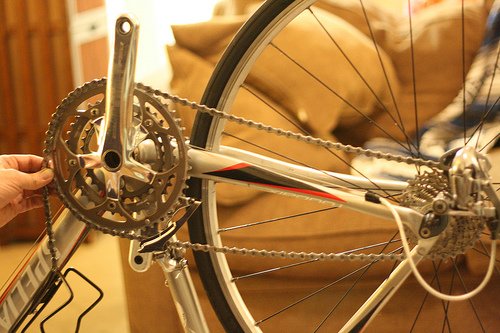
This makes the chain one inch longer to accommodate the rear derailleur.
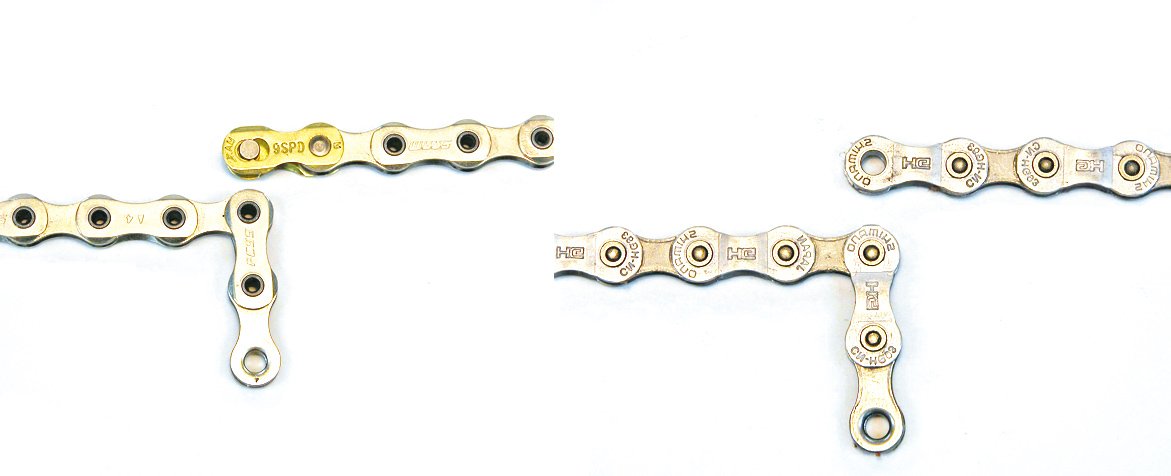
On the left is a chain with a quick link, while on the right is a “standard” chain using a connecting pin.
For bicycles with rear suspension, the suspension should be totally bottomed – compressed when using this method. See the position of travel where the rear wheel is furthest away from the cranks. To achieve this with air shocks just let the air out, while for ones with spring one has to remove the shock, remove the spring, then put the shock back. Simpler, though not 100% reliable method is adding one extra pair of inner and outer links to the length determined by the method explained below.
With modern, more and more popular systems that have one chainring in the front and multiple chainrings in the back (“1x” systems), the optimal length is achieved when adding two extra links, instead of just one, after wrapping the chain around the only front chainring and the largest rear sprocket.
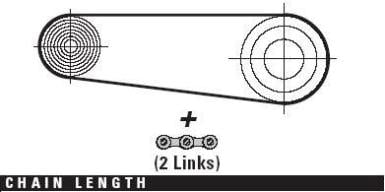
For bicycles that have more than one front chainring, i.e. those with a front derailleur.
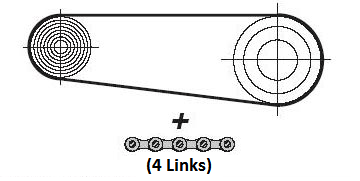
For bicycles with only one front chainring, i.e. without a front derailleur.
(see pros and cons of 1x drivetrains)
That’s all. A simple method. What to look out for?
4. Rear derailleur chain wrap capacity not big enough
Rear derailleur chain wrap capacity may not be big enough.
The explanation of what RD capacity is can be found under “Derailleur capacity” in this page: Rear derailleur.
This results in a situation that in a small-small chainring combination, the chain is too slack and can even fall off chainrings on bumpy roads.
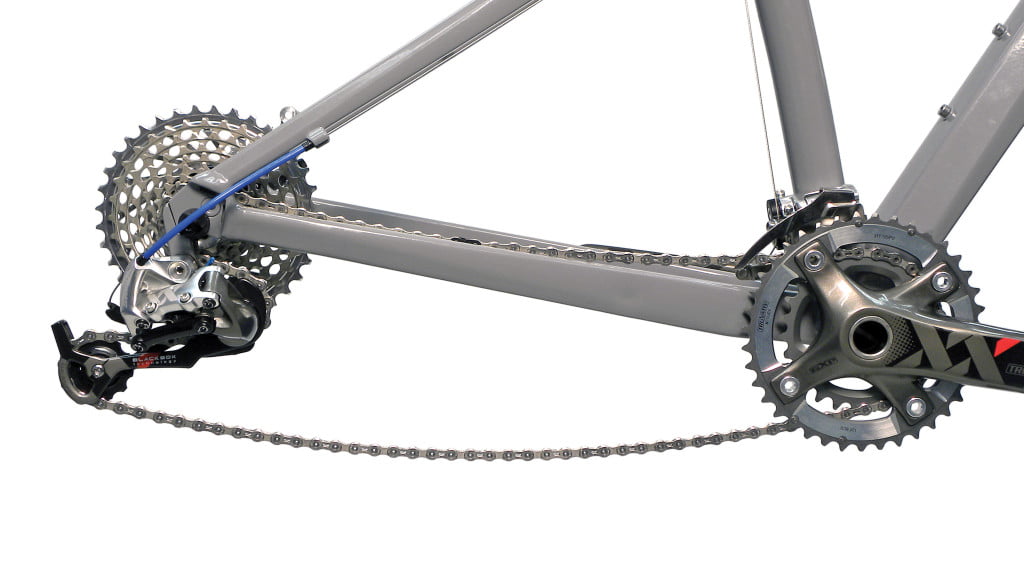
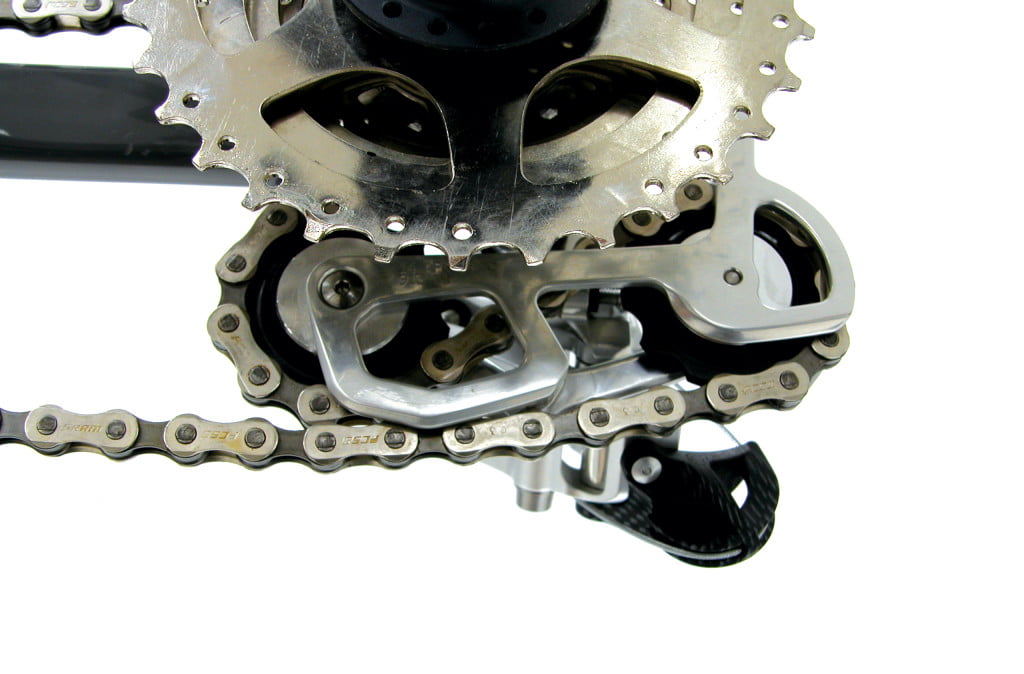
Bottom part of the chain is rubbing the top RD jockey wheel.
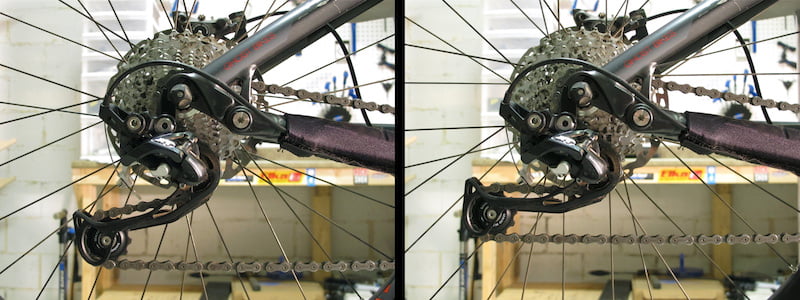
Chain to the right is still a bit too long for the RD wrap capacity, just not as extreme as in the two pictures above.
RD cage is parallel to the ground, making it hard for the RD to tighten the chain strongly enough.
This problem can be solved in three ways:
- Getting a rear derailleur with a longer cage.
- Avoiding smallest few sprockets at the cassette when the chain is on the smallest chainring in the front.
- Shortening the chain.
The third method is potentially dangerous, because in a big-big combination the chain will no longer be long enough. This can result in tearing the rear derailleur when changing to the biggest sprocket at the rear if the big chainring is used in the front.
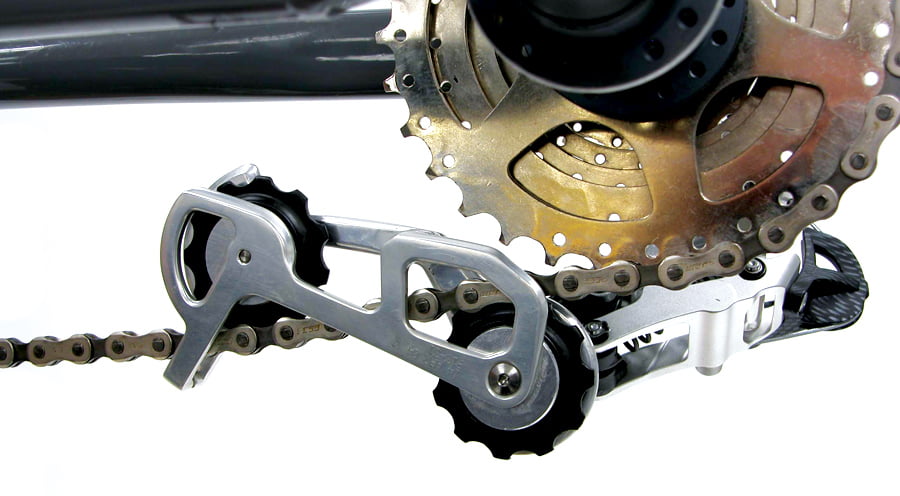
It managed to shift into big-big combo, but there is almost no bend at the derailleur jockey wheels.
Small-small and big-big combinations are combinations to avoid anyway, because the chain is cross-chained in those combos, the same gear ratio can be achieved with a middle-middle combination easily. Still, it can happen that in a moment of lesser caution, one does shift into one of those combinations. That is why, if method 1 is not possible for any reason (financial or some other), it is safer to use method 2 than method 3.
5. Shortening and re-connecting bike chains
For this, I’ve made a video demonstration:
Last updated:
Originally published:
Related post – How to lubricate a bicycle chain:

The existing comments posted under this article (questions and answers) have been moved to this BikeGremlin forum thread:
https://www.bikegremlin.net/threads/chain-length-sizing-for-bicycles-with-derailleurs-article-comments.124/

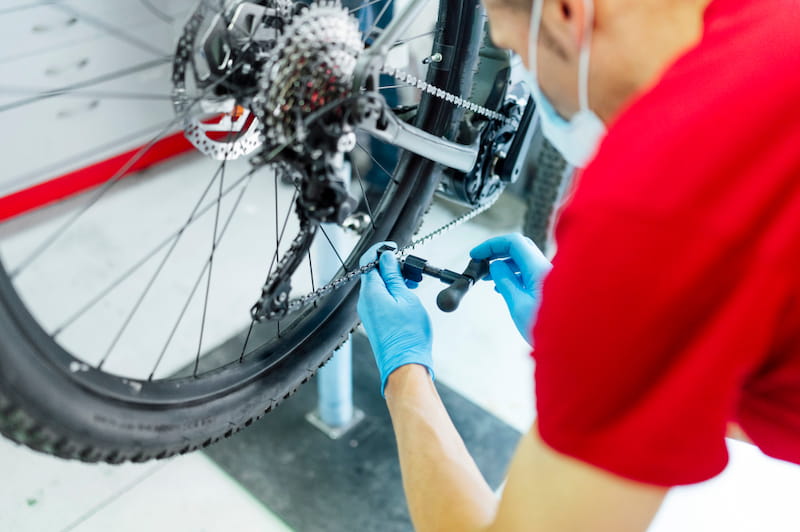
I have found that a very quick and precise way to see whether you can accommodate a cog slightly larger than the current largest cog is to select the current/big combo and then assess the chain slack by seeing how far you can push chain down at about the middle of its upper run. The chain can typically go down by at least a few inches as the derailleur cage gives up the slack. For typical chainstay lengths, a 3 inch drop means you can add one tooth with the current chain. A drop of 4.5 inches allows a two tooth increase. If you follow this procedure, the chain will likely grumble a bit on the new big/big combo. But that can be useful as a warning not to stay in that combo if you inadvertently select it.
Thanks. Will give this a try. I usually take the lower part of the chain in the big-big combo, holding two links that are not adjacent, pulling them towards each other. If there’s RD cage movement left, it will allow for the links to come closer. Depending on how much “movement” can be done this way, you can tell approximately how much more teeth can be accommodated. Just over 0.5 extra inch movement per extra tooth.
very informative information, thank you. been working on bikes for many years, and have always been curious about chain length versus derailleur position. since all I work on are mostly discarded or donated bikes I build for poorer folk, I am not always as fastidious as could be. now I can be that much better.
When you say “and then add one more inch, or one link because of the derailleur”, don’t you mean “and then add one more inch, or one link PAIR because of the derailleur”?
Well noted. I mean “one pair of inner and outer plates” – one inch in length.
I have edited the text to make it less ambigous.
Hello,
I was thinking about a new ProX o-ring chain for my dirt bike, but would like to know your suggestions on how to clean and re-lubricate the chain so that I don’t harm the o-rings or wash out the internal grease. I don’t mind taking the chain off – Can I swish the chain in a solvent tank? How do you guys do it?
Thank you,
Hi Raymond,
Just to avoid any misunderstanding – are we talking about motorcycles or bicycles?
If it’s bicycles – what are the riding conditions: sand, dust, mud, snow, or a combination of those?
Relja
Are chain typically bought new for a bicycle the right size or need to be a shortened?
Hi Michael,
Bicycle chains usually need to be shortened (cut to size).
Relja
Great article (like many in this “wiki”).
By how many links can you get the chain length “wrong” without running into trouble?
Some context: I’m considering sliding dropouts to adjust chainstay length on a self made custom frame. How much sliding dropout range is possible without having to change the chain when going from one end of the dropout range to the other?
Hi Nic,
The minimum length is determined as explained in this article.
In your case – that would be tested with the wheel furthest out from the cranks (as far as you intend to move it).
Maximum lenght generally needn’t exceed the determined minimum length – no use having those extra links.
Nonetheless, you RD chain wrap capacity is the real limiting factor here – the point when using the small-small chainring combo (front-rear) causes the chain to go as shown in the second picture in the 4th chapter in this article.
This is less problematic than using a chain that is too short – it won’t damage the RD (unless you ride for miles like that).
Hi Relja,
that makes sense if I already had the bike and could test it but I still have to build it and pick a range (10mm, 15mm, 20mm etc) for the sliding dropout. Is it possible to say how many links one can be away from the optimal length without having issues (given a MTB long cage derailleur)?
Hi Nic,
The answer depends on the drivetrain.
If you have a wide range cassette (11-40 or similar) + a wide range triple cranks, there will be less “room” for the RD to pick up any chain slack even with the optimal chain length.
In that case, perhaps one extra pair of links (1″) is as far as it will go.
With double cranks, and a more “conservative” cassette (say 11-32, or even 11-34), the long cage RD should be able to handle 2 or more extra pairs of links (2″, 4 pins/rivets).
Generally, with a long cage RD, I would expect 20 mm movement to be manageable.
But, to be certain, check the stated RD chain-wrap capacity, and see your total drivetrain tooth count difference (lareste rear minus smallest rear + largest front minus smallest front).
If you have room for 4 more teeth in terms of RD chain wrap capacity, 20 mm should be manageable.
That was an exhaustive answer, thanks a lot. I should have given you my complete specs which are: 11 speed system, 2x GRX front derailleur (30-46), 11-42 MTB cassette, Shimano XT SGS RD, and the chainstay range I’m aiming for is around 440mm if that matters. So that would make a 1 (or even 2?) chain link deviation in either direction from the mid point of the sliding dropout range possible?
Side note: I have a flat bar so I will use a flat bar road FD shifter and a MTB RD shifter. Just in case you were wondering how I will shift this Frankenstein construct.
Hi Nic,
I’d start by googling the exact RD model’s stated chain-wrap capacity.
For example, Shimano XT RD-M8130-SGS has a 39 teeth total capacity.
Shimano Deore RD-M5120-SGS has 41T.
Alivio RD-M3100-SGS has 45T.
And so on and so forth.
Your current drivetrain has a total of 47 tooth difference.
That’s huge.
Based on that, I think you will have to make a compromise:
– Either go with a chain that is a bit too short and avoid shifting to the big-big combo (to avoid damaging the RD).
– Or go with a chain that is of an optimal length for your longest (farthest) setup, and avoid using the small-small combo to avoid chain slapping too much and sliding over the jockey wheels as noted in one of my previous replies.
Alternately, you could use a 12-34 T cassette, or an 11-32 or similar, to reduce the total tooth-count difference and give yourself some room.
I suppose that moving the rear wheel by 20 mm equals roughly 1″ (1 pair of links) chain length difference, and about 4T capacity difference (in terms of RD chain wrap).
Guessing, didn’t sit down to calculate diameter differences and similar.
I was going to use an Shimano XT RD-M8000 11 speed SGS RD. Acc to https://bike.shimano.com/en-EU/product/component/deorext-m8000/RD-M8000-SGS.html it has a 47 tooth capacity. That does sound a lot in the context of the other RD you mentioned. Does that then still require the compromise you suggested? I guess not because the capacity matches.
The formula I used to calculate chain length is (in chain links) 0,157 * “chainstay length” + 1/2 “biggest front ring” + 1/2 * “biggest rear ring” + 2. The result with 445mm chainstays is 116.8 links. I got the formula from https://www.kurbelix.de/blog/anleitungen/ketten/die-richtige-laenge-der-fahrradkette-berechnen-ermitteln#:~:text=Um%20die%20richtige%20L%C3%A4nge%20der,dieses%20Ergebnis%20dann%20durch%202. This one https://www.omnicalculator.com/sports/chain-length spits out 116 for the same specifications. If I reduce chainstays length in the above formula to 430 then it’s 114.5 links. The Omni calculator website says 114 links. So the formula seems to work. Then the delta in ideal chain length for a 15mm sliding dropout is a total of 2.3 links and a 1.15 link difference when going from the ideal mid point at 437.5mm chainstay length to either end of the range. I just don’t have a clue whether 1.15 link deviation from the perfect chain length is bad enough to chause problems or might I even be able to afford a 20mm sliding dropout, or a 30mm…the more the marrier:)
Hi Nic,
Your drivetrain has 47 teeth difference in tooth count. So that RD should be able to take up all the slack if the wheel is not moved back/forth.
The optimal chain length is basically the shortest length that allows you to shift into the big-big combo without breaking anything.
If you intend to move the wheel back-forth, you should measure that in the furthest rearwards wheel position.
Then, when you move the wheel forward, the RD will have more “extra” chain length to keep wrapped (the optimal chain length is effectivelly reduced).
Moving the wheel forward by 20 mm resulty in about 3 more teeh of the needed RD capacity increase (if my math is remotely correct).
Since XT RD-M8000 chain wrap capacity is right at the limit with your drivetrain, it may not be able to pick up all the chain slack when you shift into small-small combo.
And it may not do too well for the smallest 2-3 rear chainrings when you are on the small front chainring.
In such situations, some riders prefer to cut the chain a bit shorter and avoid shifting into big-big combo.
That way, the chain will not slap as much, will be held tighter, but if you shift into big-big by mistake, you risk damaging at least the RD (possibly hanger as well).
Others prefer leaving the chain with the “safe” length, and put up with a bit more chain bounce on bumpy roads, and more noise if they shift into small-small combo.
Having said all this, the safest method is to just test.
Measure the needed chain length for the big-big combo (as explained in this article) when the wheel is furtherst to the rear.
Then install it through the derailleurs and over the chaingins, move the wheel forward, shift into the small-small combo and see if it’s all good, or too long for the RD to handle.
It might just be OK. And it might not. If it’s too long – it’s your call how you want to deal with it (shortening the chain vs leaving it with the “safe” length – as explained above).
Ok understood. I’m pretty aware of my gears and so pretty much never shift into small small so going the safe route or installing a 11-40 cassette seems the best option to me. Thanks for taking so much time out of your (days) for answering my question. Hopefully other readers learn something as well.
And just to make sure: a MTB cassette plus a rear MTB derailleur with a MTB rear derailleur shifter plus a front road derailleur with the appropriate road (flat bar) shifter works fine right? There is no chainline problem there? As far as I understand the chainline only has to match between crankset and FD.
Hi Nic,
Having your front chainrings too far out or too close inwards can prevent the FD from shifting onto a chainring.
When that is the case, chainline is usually also incorrect. I.e. when you set the chainrings to match the rear sprockets’ chainline, FD should be fine (unless it’s an exotic frame/setup).
For more details, see my article about bicycle chainline.
As far as shifting goes, the setup you noted should be OK (as long as the derailleurs match their shifters and as long as shifters match their chainrings/cassettes).
You have a new Patreon supporter;)
I will reply on the chainline entry you linked to above because this is a bit off topic for this page.
Hi, there is not much information on how to size for a 20 inch wheel mini velo.
For a front chainring 53, rear casette 11-32 setup. Do i add two or four links when measuring the big/big?
Hi,
If it’s a one-by (1x), I’d size the chain as explained for the one-by drivetrains, i.e. add 2 inches (i.e. 2 pairs of inner+outer links, i.e. 4 chain pins).
Hi,
What a great resource! Thank you.
My question regards swapping front chainrings on a 1 X system. I want to be able to run two different sized front chainrings that I can swap out depending on the terrain.
I run an eThirteen 9 to 50 cassette and want to be able to swap out a Wolf Tooth Camo 38 front chainring to a Wolf Tooth Camo 28 front chainring.
Chain length calculators estimate that with my 450cms chainstays, the length of my chain with the 38 front chainring will be 148cms (116 links) but 142cms (111 links) with the 28 front chainring.
Is this difference going to be OK for the SRAM 1 x X01 Rear Derailleur to handle? Or am I going to experience the chain dropping or rubbing the chainstay, when I switch to the 28 front chainring?
Many thanks in advance.
Hi Carlos,
To answer that question, we need two pieces of information:
1) The total chain wrap capacity needed (tooth count).
2) The chain wrap capacity of your rear derailleur.
For the first piece of info, here is the calculation:
(50-9) + (38-28) = 41 + 10 = 51
Now, since we’re using a 1x drivetrain, we should also add two more teeth just in case, to avoid any chain slap, and to assure a good chain retention.
That’s why I’d look for a RD with a 53T chain wrap capacity in order to handle the front chainring swap.
Even 51 is way beyond the range of most RDs, even the long-cage 1x ones.
Alternativelly, you could cut the chain a bit shorter.
That way, you would avoid any chain slap, or chain tropping when using the smaller front chainting (the 28T one).
However, if you do that, you risk damaging the RD (and/or RD hanger and frame, spokes, wheel…) if you shift on the largest few sprockets while using the larger, 38T, front chainring.
Likewise, you could cut the chain to the optimal length for the larger chainring (38T), and in that case, the risk is just more probable chain drop if shifting to the smallest few sprockets when using the smaller front chainring (the 28T one).
Thank you Relja.
Much appreciated!
I´ve tried to research the chain wrap capacity of the 1 X SRAM AXS X01 Eagle Rear Derailleur that I have but cannot find a definitive size. SRAM mention that it “It features a shorter cage for 10mm more ground clearance, with more chain wrap on the cassette to sit slightly further forward, and further inboard from mechanical Eagle.” but don’t give a definitive answer. Unhelpfully, they only give a maximum tooth which is 52T.
As you say the 51T difference would appear to be pretty big and that´s why I asked the question.
The 28T and 9 to 50 cassette will give me a range of 16.23 to 90.15 gear inches. If I cut the chain “long” i.e. normally, due to chain drop/rub, I may have to go without say the last three sprockets (9T, 11T and 13T) which would leave me with an upper maximum of 54.21 gear inches, which may mean that I spin out quite a lot.
The 38T and 9 to 50 cassette will give me a range of 22.03 to 122.33 gear inches. If I cut the chain short, it may just mean that I have to go without the top two sprockets (42T and 50T) which would still leave me with an lower maximum of 30.73 gear inches, which being a pretty good climber, I feel can live with.
In this case am I right in thinking that my initial calculation would be (36-9) + (38-28) = 27 + 10 = 37? If so, How have you any idea how short I would cut the chain? 116 links (148cms) is what most chain length calculators advise for a 38T.
The alternative would be to buy a 34T to close the differential a bit to account for the chain wrap capacity but without knowing what that exactly is for the RD I have, I think I may just opt for cutting the chain a little shorter and not changing up into the last two sprockets, when I have the 38T on.
Thank you once again.
Thinking about it, I may be able to answer my own question of how short the chain would need to be;
Using a chain length calculator, 28T on the front and 50T on the back will require 112 links.
On a 38T at the front, according to the same chain length calculator 112 links will enable me to chain up till 42T on the back but no more.
Am I missing something?
Hi Carlos,
I usually take chain-length calculator results, print them out, and use the paper to start a barbecue. 🙂
On a more serious note:
I size the chains using the method explained in this article.
It is the most accurate, and has given me the best results.
If you intend to do the chainring swapping, you must decide which limitations you are happy with.
There are basically two options:
1) Not using the smallest few rear sprockets with the smaller chainring (28T).
In that case, I’d size the chain as shown in this article using the larger chainring (the 38T one).
2) Not using the largest few rear sprockets with the larger chainring (38T) (i.e. no chain slap with the smaller chainring).
In that case, chain sizing would go a bit differently.
I’d size the chain by using the smaller front chainring. But:
I would shift into the smallest sprocket at the rear.
Then, cut the chain to the longest length that allows the RD cage to wrap it
(so NOT having the chain look like in either of the first two pictures in chapter 4 of this article).
Alternativelly, for option 2), you could size the chain using the smaller chainring and the method described in this article.
This will give you the optimal chain lenght for the smaller chainring.
However, the method 2) explained in this comment will let you run with the longest possible chain for the smaller 28T chainring and your RD, so it might “buy” you a few more useful large rear sprockets when you are using the larger (38T) chainring. At the cost of having the chain length less-than-optimal for the 28T chainring.
Not sure how well I’ve explained my reasoning, but I hope the procedures are clear enough at least.
And, of course, you are free to use your prefered chain-sizing method, including the chain-lenght calculator, as long as you are aware of the limitations (it seems that you understand the problem correctly, as far as I figure based on your follow-up comments).
Or alternatively, I would wrap the new chain around the 38T chainring and 42T sprocket (instead of the 50T) and add the 2 extra links that I usually do?
Or wrap the new chain around the 38T chainring and 42T sprocket (instead of the 50T sprocket) and add two links, in the normal way?
Hi Relja.
Thanks for the confirmation.
Best wishes and many thanks,
I have a specialized cross trail bike that I modded to be a 27 speed as the original 18 2x front and 9x rear was to easy for me to ride. What length chain would I need for that?
Hi Paul,
It’ best to measure the chain on the bike – as explained in this article.
So, wrap the chain around the largest front and the largest rear chainring, then add 1″ (one pair of outer and inner plates, or three pins – however it’s easier to visualize).
As the chains are cut in 1″ (link pair) increments, in case you must choose between having 1.5″or 0.5″ longer, round up (to 1.5″, i.e. to three instead of two plates length, or 4 connecting pins).
Relja